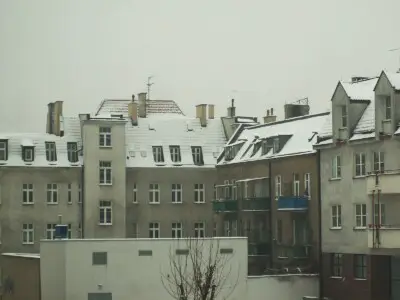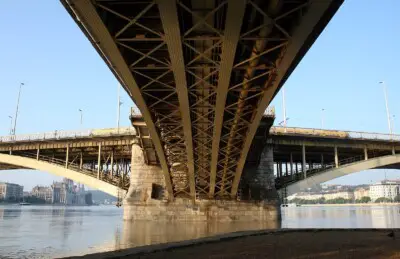Geometry and trigonometry students are quite familiar with triangles. Students study lots of facts about triangles, prove lots of theorems about triangles and generally use triangles for a significant part of their high school math career!
The Isosceles Triangle Theorem. The Pythagorean Theorem. Proving two triangles are congruent. SOH CAH TOA (do you recognize this one?) And the list goes on. Aside from geometry and trigonometry, how are triangles used in real life?

It’s pretty tough to go anywhere without seeing triangles. If you drive, you’ll likely encounter yield signs, which are equilateral triangles, easily recognizable even from a far distance because of their unique shape.
In elementary school, you may have played the triangle in the school band? (It’s a pretty limited instrument). What are some other examples of triangles?
In this article, we’ll look at several different uses and examples of triangles in the world outside of the math classroom. Let’s get started.
Roofs
A pitched roof is a roof that slopes downwards, generally in two parts from a central ridge. The “pitch” of the roof is defined as the ratio of the vertical rise to the horizontal span.

It measures its steepness. (Math students, does this sound familiar by any chance? Think: slope of a line.) The pitch can also be defined as the angle the roof forms with the horizontal base.
(Source: wikipedia.org)
The shape of the pitched roof is a triangle. The simplest type of pitched roof uses a single triangle, though there are many variations where there can be two or more pitched roofs joined together.
The roof of a house or a building is a crucial element in the structure. It protects the home or building from the elements – wind, rain, snow.
Pitched roofs on homes are very popular to allow for the rain to roll off the roof and not accumulate. Similarly, pitched roofs minimize the debris that can cover a roof and clog gutters. The triangle is the perfect shape for this!

Bridges
In construction, it turns out that triangles are a strong shape that can bear weight. Triangles are often used in building bridges. They are very stable shapes that help balance the tension and compression of the forces.

Truss bridges, for example, use equilateral triangles and isosceles triangles in their construction. Truss bridges are often used to support railroad tracks or pedestrian bridges.

The triangle shapes allow the weight to be distributed evenly so that the bridge can bear all of the weight.
“Triangles are one of the best shapes for distributing weight because they take force from a single point and distribute it across a wide base.” (Source: flexbooks.ck12.org)
The Pyramids in Egypt
How and why did the Egyptians use triangles in the building of the pyramids? Let’s look at the Pyramids of Giza, of which the Great Pyramid is the largest.

Source: commons.wikimedia.org author: Emőke Dénes
The Great Pyramid of Giza is one of the Seven Wonders of the Ancient World; in fact, it’s actually the only Ancient Wonder that’s still standing.
That’s pretty impressive considering the Egyptians built these pyramids around 4,000 years ago! Technically, the Great Pyramid of Giza is a square pyramid; that is, it has a square base and the walls of the pyramid are made up of triangles.
There are many theories as to why the Egyptians used pyramids and triangles in their construction of the pyramids. Practically speaking, the pyramid is a stable structure, in part because of its wide base, and the uniform narrowing of the structure from base to vertex.
Researchers also theorize that the Egyptians built the pyramids as giant tombs for the pharaohs, with the shape pointing upward, to eternity. (Source: pbs.org)
One interesting theory about the Egyptian pyramids – researchers believe they used the Pythagorean triple 3-4-5 to construct the pyramids – this was before Pythagoras!
It’s believed that the Egyptians tied knots in rope to create 3, 4, and 5 equal spaces. Check out how they may have done this here: wowstem.org. The tool they created ensured that their measurements would be accurate.
(The Louvre is another pyramid from a more modern era).
Sailing
Have you ever drawn a picture of a simple sailboat? If so, you likely used triangles to draw it. This begs the question, why are sails triangular?

Source: britannica.com
In ancient times, square sails were more commonly used on ships. The disadvantage of a square sail is that it only allows for sailing in the same direction as the wind.
In medieval times, the lateen sail, which is a triangular sail, was popularized. The lateen sail allows a sailboat to take wind from either side.
This permits a sailboat to move against the wind more easily, since the boat can be tacked to face more forward. Lateen sails also cause less drag which makes it a better sail in less windy conditions. (Source: lifeofsailing.com)
Triangular sails also help boats to gain more speed as compared with square sails. The triangular sails allow sailboats to catch wind from many more angles. Essentially, the triangular sails allow the sailboat to move more quickly through the water.

It’s fair to say that the triangular sails revolutionized sailing!!!
Art
Many artists employ the use of triangles in their artwork. Michael Brent on ehow.com puts it this way:
“Many works of art are composed in a triangular manner that is meant to draw our eyes to an area of focus within a subtle triangle shape.”
Michael Brent, ehow.com
An example of this is Leonardo DaVinci’s The Mona Lisa. This masterpiece has a triangular composition; larger at the top and wider at the base. Our eye is drawn right into the center of the canvas.
It is thought that the use of a triangle in the composition of art also helps achieve a sense of balance to the overall work, by basing the painting on a geometrical shape.

commons.wikimedia.org author Josh Hallett
In modern times, many companies incorporate triangles into their design logos. Businesses know that the triangle is an appealing shape!
Companies know that different shapes can send different messages to consumers. Triangles are sharp and directional; they make a statement.
You don’t have to look very hard to find logos that incorporate triangles. The creative agency Fabrik says of the Bass logo, shown below, that, “The bright red triangle is also pointing upwards, which commonly conveys a sense of creativity and growth.”

See if you can guess which logos these are:


Quilting
Triangles are found in quilts the world over! You don’t have to go very far to find right triangles, equilateral triangles, or isosceles triangles in a quilt. The “Corn and Beans” quilt below has so many triangles it would be difficult to count them all.

“Corn and Beans” quilt in the Charles Hotel, Cambridge, MA, circa 1900
A very common quilt design used in traditional quilts is “flying geese.” Flying geese are sometimes used as the overall design of an entire quilt; at other times, they’re used as a design element.

The Bermuda Triangle
Perhaps one of the most famous triangles is the Bermuda Triangle. The Bermuda Triangle covers about 500,000 square miles of ocean off the Southeastern tip of Florida.
It’s roughly bounded by Miami, Puerto Rico, and Bermuda. The Bermuda Triangle grew in infamy because of the mysterious disappearances of ships and aircraft. Many incidents have occurred in which planes or ships disappeared or were abandoned somewhere in the Bermuda Triangle.
In 1918, the USS Cyclops, left Barbados with its 306 crew and passengers on its way to Baltimore, Maryland. The ship never got there and was lost in the Bermuda Triangle. One of the most famous incidents involved a naval seaplane, carrying twelve men.
At some point, communication was lost. After an extensive ten day search, nothing was found and the disappearance remains a mystery. For a thorough list of disappearances and incidents, check out Bermuda Triangle Incidents.
Next time you’re out and about, take a look around. See how many triangles you can see in the vicinity! You may be surprised.
You can learn about similar triangles (and what they mean) here.
You can learn about the Triangle Inequality here.
You can learn about uses of hexagons (and appearances in nature) here.
I hope you found this article helpful. If so, please share it with someone who can use the information.
Don’t forget to subscribe to our YouTube channel & get updates on new math videos!
About the author:
Jean-Marie Gard is an independent math teacher and tutor based in Massachusetts. You can get in touch with Jean-Marie at https://testpreptoday.com/.



